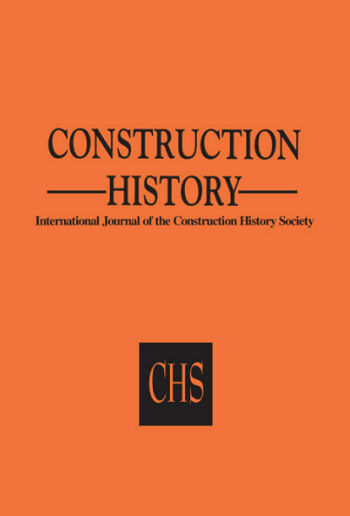Construction History Vol 36, No 2, 2021
Construction History (Vol 36, No 2, 2021) presents its usual international outlook. Two papers may be of particular interest. We tend to think of the conservation of buildings as completed without necessarily thinking about how they were originally assembled. A paper by Stefan M Holzer examines the role of the temporary works needed for medieval construction through to the early industrial period, with particular reference to methods of scaffolding, the use of cranes, and the materials and structures that were in operation on these early sites.
Holzer highlights the close interdependencies between scaffolding, lifting machines and material types on the historic construction site. When in the middle ages cranes played a subordinate role, most of the transport of building materials had to be by carriers, who required convenient sound and stable scaffolding (mostly pole scaffolding) to serve the masons just in time. The progress in lifting machinery, notably from the late 14th century onwards, alleviated the pressure on scaffolds, and may have permitted the use of lighter or more basic scaffolding, while big ashlar blocks were assembled directly from the cranes. The development of robust rotative cranes spurred this development, and the rediscovery of the Vitruvian gin pole had the same effect.
The second paper, by Keith Parry, deals with the repair and maintenance of the wooden bridge over the Thames at Marlow between 1620 and 1820. The bridge was set on a series of wooden piles grouped in ranges, linked together by wooden joints. It was typical of many bridges spanning the Thames between Reading and London. Rents from the Bridge Estate funded the repairs and two bridgemasters recorded their income and expenditure over two centuries. This permits analysis of records that show that the cycles of bridge closure of repair and replacement by a ferry averaged 11 years.
Also of note in this issue are articles about the construction of the city wall at Pompeii; brickmaking production in medieval Novgorod; a history of early reinforced concrete in modern Shanghai (1890–1914); and the spreading regional development of the railway system in São Paulo, Brazil.
This article originally appeared in the Institute of Historic Building Conservation’s (IHBC’s) Context 172, published in June 2022. It was written by Bob Kindred MBE.
--Institute of Historic Building Conservation
Related articles on Designing Buildings
IHBC NewsBlog
IHBC Membership Journal Context - Latest Issue on 'Hadrian's Wall' Published
The issue includes takes on the wall 'end-to-end' including 'the man who saved it'.
Heritage Building Retrofit Toolkit developed by City of London and Purcell
The toolkit is designed to provide clear and actionable guidance for owners, occupiers and caretakers of historic and listed buildings.
70 countries sign Declaration de Chaillot at Buildings & Climate Global Forum
The declaration is a foundational document enabling progress towards a ‘rapid, fair, and effective transition of the buildings sector’
Bookings open for IHBC Annual School 12-15 June 2024
Theme: Place and Building Care - Finance, Policy and People in Conservation Practice
Rare Sliding Canal Bridge in the UK gets a Major Update
A moveable rail bridge over the Stainforth and Keadby Canal in the Midlands in England has been completely overhauled.
'Restoration and Renewal: Developing the strategic case' Published
The House of Commons Library has published the research briefing, outlining the different options for the Palace of Westminster.
Brum’s Broad Street skyscraper plans approved with unusual rule for residents
A report by a council officer says that the development would provide for a mix of accommodation in a ‘high quality, secure environment...
English Housing Survey 2022 to 2023
Initial findings from the English Housing Survey 2022 to 2023 have been published.
Audit Wales research report: Sustainable development?
A new report from Audit Wales examines how Welsh Councils are supporting repurposing and regeneration of vacant properties and brownfield sites.
New Guidance Launched on ‘Understanding Special Historic Interest in Listing’
Historic England (HE) has published this guidance to help people better understand special historic interest, one of the two main criteria used to decide whether a building can be listed or not.


















